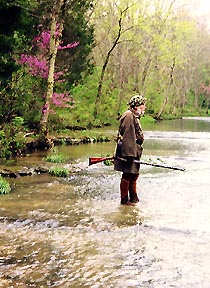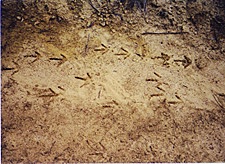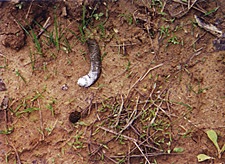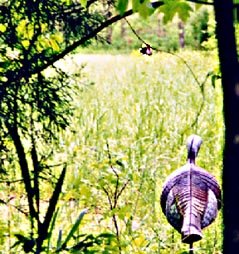

When I bought my first flintlock smoothbore from Jackie Brown in June of 1997, I set myself a goal which has been the source of considerable hunting pleasure. Since its reputation for versatility was one of the main factors in my decision to try the smoothbore, I decided to use the gun for all my hunting in the following season, for large game and small. In addition, I decided to add turkeys to the list, although I had never hunted turkeys, before. I knew this last one would be difficult to accomplish, but a complete and fair test of the gun seemed to demand it.
The small game seasons went along smoothly that fall, and I collected rabbits, squirrels and doves without undue problems. A fat doe fell to a round ball, also, and I had only one species remaining, turkeys in the spring gobbler season. Working up the loads for all the different game I hunted was a great deal of fun, and the gun seemed to be living up to its reputation, and then some. It fit me beautifully and was a natural shooter, in spite of its 46 inch barrel.
I'll never forget that first turkey season. Never have I worked so long and hard trying to collect a single head of game. When it was over, I was worn to a frazzle. Being a complete neophyte at turkeys, I arranged to hunt with a friend who was moderately experienced. We hunted a farm with great turkey habitat and a good population on most of its one hundred and thirty acres. We hit it every day well before daylight, hunted long and hard, and Tandy showed me the ins-and-outs of turkey hunting. He chose the spots, did the calling, made all the decisions, and I soaked it all in.
 Right from the start we were aware of one big gobbler which stayed on the top of a ridge on which there was an old cemetery. Tandy said he was the boss gobbler of the area, and that proved to be true. We named him Boss Gobbler of Cemetery Ridge and called him 'BG' for short. The problem with 'BG' was that his range was not usually on our farm. We could hear him, occasionally see him, but couldn't go to him, and he absolutely would not move off his ridge. With the harem he had collected, who could blame him?
Right from the start we were aware of one big gobbler which stayed on the top of a ridge on which there was an old cemetery. Tandy said he was the boss gobbler of the area, and that proved to be true. We named him Boss Gobbler of Cemetery Ridge and called him 'BG' for short. The problem with 'BG' was that his range was not usually on our farm. We could hear him, occasionally see him, but couldn't go to him, and he absolutely would not move off his ridge. With the harem he had collected, who could blame him?
We saw a lot of other turkeys and tried every trick in Tandy's book, all to no avail. We never had a single bird come to our set-up in the whole time. Tandy's time was limited, and after about 4 days of this routine, he left me on my own. Talk about a greenhorn! I felt totally lost.
I continued hunting every day, usually both morning and afternoon, and hunted a total of seventeen days out of the twenty-one day season. I really wanted that first turkey, any first turkey, and I let nothing stand in my way. Rain or shine, cold, windy, sleepy and tired, no matter, I was out there hitting it hard.
In addition to trying to take a turkey with a smoothbore, I had also decided to do it in full period dress, so I was wandering the hills in my impression of a Kentucky settler of 1778, with moccasins and leggings, knee breeches and waistcoat, muslin shirt and wool rifle shirt of a sort. My only concession to all the modern turkey hunting methods were a few strips of camouflage tape on my gun, a mesh face mask which I wore while on a set, a knit wool cap and camo finger gloves. Oh, and, yes, one foam hen decoy. Since there was a stream through the middle of the hunting area, I spent every day with feet wet to the knees from wading the creek many times each day. Cold in Kentucky in April.
My gun was Jackie Brown's Carolina Smoothbore in 20 gauge, with a large Siler lock, sliding wooden patchbox, iron furniture and a 46 inch barrel in cylinder bore. I had spent considerable time working up a load, and was shooting 80 grains of Goex FFFg, a card overpowder wad, a half-inch paper cushion wad lubricated with melted lard and 2 oz. of #6 chilled shot. I had proved to myself many times that this load would put an average of 8 pellets into the skull and neck bones of a full scale silhouette of a turkey's head and neck at twenty-five yards. Every time. I was sure I could kill a turkey with it, as long as I limited my range to twenty-five yards.


The days came and went, until they began to blur together. Kentucky in April is a beautiful place, and spending that much time out in the natural world was all I could wish. I was enjoying myself tremendously and learning a lot. I studied turkey droppings and tracks, strutting grounds and dusting areas. I had hens walk within ten feet, saw many, many jakes and toms at a distance, but could never get close. All the while, in the back of my head was the awareness that time was getting short, and that my first turkey, my turkey with a flintlock smoothbore, and my personal 'grand slam' of game taken with it in the first season were becoming rapidly less likely.
I started not to hunt that last day of the season. My confidence was zero, my bones ached, and I needed some rest. It was raining and windy, early, so I slept in. I couldn't stand the pressure when the weather showed some signs of clearing, though, and went out at noon for one last try. What's a little wind and rain when the opportunity is slipping away so quickly?
 The early afternoon was the same as all which had gone before, but things picked up about 4:00 o'clock. I spotted some toms in a field across the creek and put the sneak on them. Waded the creek and stepped into the corner of a small field, watching the toms at a long distance to my left, and then spotted a hen about 150 yards away to my right, in my same field. I hit the dirt on my belly and watched her, expecting her to bolt, but she didn't seem aware of me. I got my decoy out of my haversack and assembled it, crawled forward just a bit and stuck it in the ground, then used it as cover while I snaked backward for 15 yards, dragging my smoothbore and haversack behind me. I have no idea why she didn't panic, but I managed to get into the brush and set up, and she remained calm. Now, the toms I had been stalking began moving in my direction, and also five or six other hens moved into my field. Then, there was a distinctive, familiar gobble from behind the first hen, and out of the brush stepped none other than old 'BG', himself. 'BG' had come down off his hill! Adrenalin time!
The early afternoon was the same as all which had gone before, but things picked up about 4:00 o'clock. I spotted some toms in a field across the creek and put the sneak on them. Waded the creek and stepped into the corner of a small field, watching the toms at a long distance to my left, and then spotted a hen about 150 yards away to my right, in my same field. I hit the dirt on my belly and watched her, expecting her to bolt, but she didn't seem aware of me. I got my decoy out of my haversack and assembled it, crawled forward just a bit and stuck it in the ground, then used it as cover while I snaked backward for 15 yards, dragging my smoothbore and haversack behind me. I have no idea why she didn't panic, but I managed to get into the brush and set up, and she remained calm. Now, the toms I had been stalking began moving in my direction, and also five or six other hens moved into my field. Then, there was a distinctive, familiar gobble from behind the first hen, and out of the brush stepped none other than old 'BG', himself. 'BG' had come down off his hill! Adrenalin time!
What to do? Turkeys, and turkey eyes, everywhere! My set-up was pretty good, if a little open, the decoy was 15 yards out with 'BG' straight beyond it, about 150 yards away, strutting his stuff. Oh, to be a good caller. Oh, well, do the best you can with the cards you have. I began to call softly, just a few plain yelps with a few soft purrs and whines. Not a turkey fled in alarm, much to my surprise. In all my years of hunting, I've experienced some very exciting times, but nothing even remotely like the next forty-five minutes. 'BG' strutted round and round, gobbling his fool head off, the other toms and jakes all got together for a bragging contest in the middle of the field, the hens wandered around feeding, seemingly oblivious to all the testosterone in that field, and I sat with all my senses glued to the scene, calling in my amateurish way at long intervals. Turkeys cussed and threatened, fought and ran, fed and strutted, and I watched in amazement.
After a little while, it dawned on me that 'BG' was making slow progress in my direction as he circled and gobbled. I watched the distance decrease, ever so slowly, and began to hope he might  actually come into range. When he was about seventy-five yards out, another tom challenged him and they sparred for a bit, but the challenger soon backed off, and 'BG' resumed his circling and strutting, moving slowly my way, then slowly the other. It took him that long 45 minutes, but he finally worked his way down to 30 yards from the muzzle. And stopped. He kept strutting and popping, but was circling in place. What to do? I had had my bead on him for a long time, and he was almost, just almost where I wanted him. What's five little yards? Last day of the season, getting dark, my only opportunity for a shot at a turkey this year, my first shot...after ten minutes of his tantalizing circling, at a moment when he had turned to the side and broken his strut, I put the blade on his neck below his head and squeezed the trigger. A satisfying roar and a huge billow of smoke in the damp air, and everything disappeared. I knew he was down, couldn't have missed. When the smoke cleared a bit in a few seconds, though, no 'BG'. Gone, kaput, disappeared without a trace. The other turkeys hotfooted it to the woods and set up a great clatter of alarm putts, but was 'BG' with them? I don't know to this day. A half hour of diligent searching turned up only three broken breast feathers and a few scratches in the dirt, right at a paced 30 yards, as I had estimated. I had missed him. Blast! Double BLAST!!
actually come into range. When he was about seventy-five yards out, another tom challenged him and they sparred for a bit, but the challenger soon backed off, and 'BG' resumed his circling and strutting, moving slowly my way, then slowly the other. It took him that long 45 minutes, but he finally worked his way down to 30 yards from the muzzle. And stopped. He kept strutting and popping, but was circling in place. What to do? I had had my bead on him for a long time, and he was almost, just almost where I wanted him. What's five little yards? Last day of the season, getting dark, my only opportunity for a shot at a turkey this year, my first shot...after ten minutes of his tantalizing circling, at a moment when he had turned to the side and broken his strut, I put the blade on his neck below his head and squeezed the trigger. A satisfying roar and a huge billow of smoke in the damp air, and everything disappeared. I knew he was down, couldn't have missed. When the smoke cleared a bit in a few seconds, though, no 'BG'. Gone, kaput, disappeared without a trace. The other turkeys hotfooted it to the woods and set up a great clatter of alarm putts, but was 'BG' with them? I don't know to this day. A half hour of diligent searching turned up only three broken breast feathers and a few scratches in the dirt, right at a paced 30 yards, as I had estimated. I had missed him. Blast! Double BLAST!!
So, season number one with the smoothbore was an experience I won't forget, maybe my best season ever, but I had failed to collect all the game in one year. I had become a turkey hunter, though, had learned something of their ways, had called in the big boss gobbler and taken my shot, which ain't bad for a greenhorn.
The next year passed slowly, and when the fall hunting seasons rolled around once more, I took, in order as they came, all the small game and a doe with the smoothbore, for the second time. My attention was on the following spring, though, and that first turkey.
What a difference a year makes! Turkey season this year was as different from last as is possible. That's probably a good thing, because I wasn't at all sure these old bones had a repeat of last year left in them.
Opening day of the spring gobbler season in 1999 found me standing at 5:30 AM by the edge of that same cold, wet stream of last year, in the dark, waiting for the turkeys to sound off. Tandy and I had scouted the area the evening before, and "roosted" three birds. The one we decided on was about 150 yards up the slope from us, beyond an area of heavy trash and on our side of the creek. We considered and chatted, finally decided to cross the creek, move even with him and see if we could make him fly over the trash and into our set-up as he left his roost tree.
That water was still cold.
I was dressed the same as last year, except that I had learned a bit about turkeys and now didn't use a face mask, only a black neckerchief pulled up over my nose, and some fingerless gloves which I had knitted during the winter. My trusty smoothbore was also loaded a little differently. Some serious patterning had seemed to show better patterns with 1 5/8 oz. of #6 shot instead of the 2 oz of last year. Maybe the increased velocity of this load would prove beneficial, too.
We made a quick set-up with our backs to the creek and the turkey, facing a meadow, with our decoys 25 yards out. Tandy began to call, and the turkey answered, immediately. He answered several times for the next five minutes, then shut up. I thought he was gone, but Tandy saw him fly over the trash, over the creek, and into our field, 150 yards down the creek to my left. In a very short time, I spotted him ...a jake... in the corner of my eye, moving steadily to the decoys. I held on a spot and let him walk into it, 25 yards out, and squeezed the trigger. Instant ignition, but not so much smoke this time, and I saw the turkey smashed down as if by a big fist. Hot damn! He didn't stay down, though, got up and headed for the woods, with both of us hot on his heels. He only made 50 yards and died in the edge of the woods. I had my first turkey! Took it with a cylinder bore 20 gauge smoothbore flintlock, too, while dressed in full settler's kit of 1778!
and the turkey answered, immediately. He answered several times for the next five minutes, then shut up. I thought he was gone, but Tandy saw him fly over the trash, over the creek, and into our field, 150 yards down the creek to my left. In a very short time, I spotted him ...a jake... in the corner of my eye, moving steadily to the decoys. I held on a spot and let him walk into it, 25 yards out, and squeezed the trigger. Instant ignition, but not so much smoke this time, and I saw the turkey smashed down as if by a big fist. Hot damn! He didn't stay down, though, got up and headed for the woods, with both of us hot on his heels. He only made 50 yards and died in the edge of the woods. I had my first turkey! Took it with a cylinder bore 20 gauge smoothbore flintlock, too, while dressed in full settler's kit of 1778!
Tandy and I returned the next morning, and Tandy took his first bird of the season with about as much ease. Haven't been able to wean him of his smokeless ways, but I'm still working on it.
The third day of the season, I was back at it, this time alone. I hunted in several places, and then wound up in a set-up by an old road where I had found signs of a turkey strutting on our preseason scout. I had a comfortable spot, this time, with a large sycamore tree as a backrest, a flat stone for a seat and a root for an armrest. My decoys were 20 yards in front, and there was a good screen of brush. The early bird may catch the worm, but he's no doubt sleepy when he does it. As I sat there all relaxed and warm, watching and listening, I dozed off and slept for a half-hour. When I awoke, at about 11:00 o'clock, the first thing I saw was two turkeys across the creek, 250 yards away. I called a series of yelps, and they both broke into a run. They angled across in front of me to the creek, crossed and came into view 100 yards away in a hayfield. I called again, softly this time. As if on a string, they made a beeline for me, came through a gap in the brush and straight up to the decoys. Two fat jakes. When the lead bird got to the decoy and stopped, twenty-two yards out, I took the shot. Again, I saw him smashed down, but there was no getting up, this time. That slow, fatal wingbeat told me I had taken my second turkey with the smoothbore while in full 1778 kit, and this time I had done it all by myself.

I have to say the reputation of the smoothbore for versatility is well deserved. I've hunted two full years with mine, now, and have taken small game, deer and turkey, two of each. Not exactly the way I had planned it in the beginning, but it's a good average, and I'll take it!
Copyright © 1999 B. E. Spencer